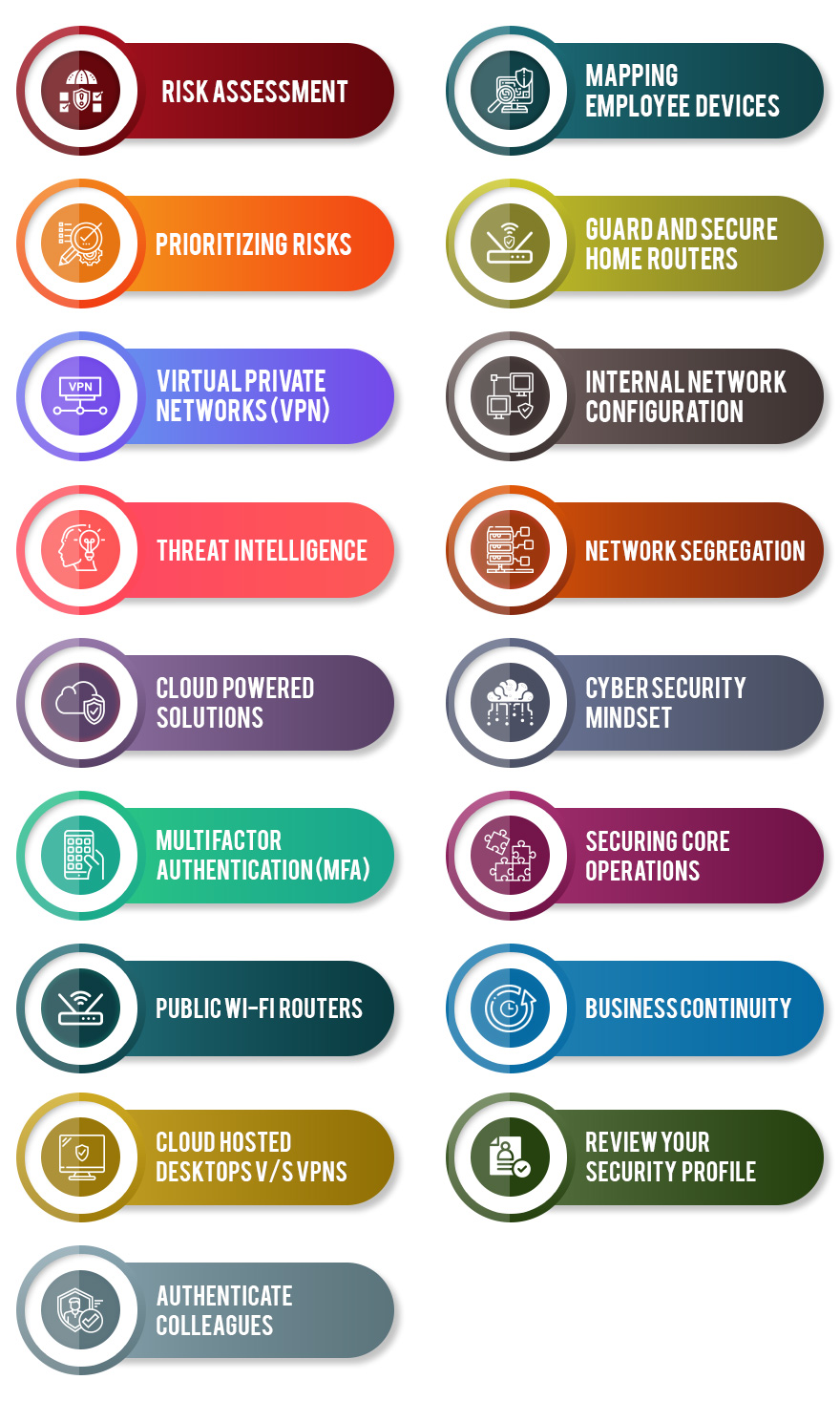Remote work is rapidly becoming the new “normal” for technology driven organizations. While most of the recent remote work initiatives were fuelled by the Covid-19 pandemic, the trend is likely to gain even more momentum once we are past this crisis.

In this post, we will outline some Cyber Security Measures and best practices that can beef up the security of your remote work environment. As most recent remote work scenarios were implemented in haste, they are more vulnerable to cyber threats.
Risk Assessment
Securing remote work starts with a detailed assessment of your organization’s risk profile. You have to sit on the drawing board and identify major weak links that are unique to your industry and the way you conduct routine business.
Prioritizing Risks
You can’t address all potential risks in a single stretch. Instead, go for a staggered approach in which you prioritize the threats relative to their intensity, urgency and the level of damage they can inflict on your organization’s data or operations.
Virtual Private Networks (VPN)
As most organizations are operating in a full on remote work setting, an effective VPN solution can be a strong line of defense against external threats. However, your VPN will only be as effective as how well it “wraps” all employee devices accessing data.
Threat Intelligence
Lately, most organizations that become a victim of any cyber attack are quick to relay this information to other entities that may be vulnerable. You have to keep a vigilant eye for the latest cyber attacks and even such attempts to try and stay ahead of the curve.
Cloud Powered Solutions
Most Cloud Service Providers (CSP) like dinCloud are super vigilant about the physical and cyber security profile of their cloud services. Cloud based solutions are otherwise naturally suited to supporting a remote workforce. A cloud powered service should be your top pick.
Multi Factor Authentication (MFA)
Currently, your employees may be using a host of devices to access company data and apps remotely. Securing each end point device, especially employees’ personal devices is otherwise not possible. An MFA Solution is a highly effective means of validating legit users.
Public Wi-Fi Routers H2
While they are very enticing, it is never a prudent option to use open or public Wi-Fi connections. This is particularly true for the current uncertain times in which cyber attacks and infiltration incidents are otherwise touching record levels.
Cloud Hosted Desktops v/s VPNs
While VPNs are a strong line of defense, they have their own limitations. Instead, you can provision Cloud Hosted Virtual Desktops like the ones offered by dinCloud. Our dinHVDs are a secure, reliable and robust solution to power your remote work needs.
Authenticate Colleagues
Whenever you receive an email or file from a co worker that contains links or executable files, never open them directly. A hacker may be impersonating one of your colleagues. It is always better to inquire from that colleague first over phone or Skype, before you proceed.
Mapping Employee Devices
In remote work scenarios, your employees may be using a host of devices to access company data or apps. You need to map, authenticate and monitor each device that employees are using to execute remote work. This can be a good test for any intrusion.
Guard and Secure Home Routers
As most domestic routers are plug n play devices, we seldom change their default settings and passwords. However, in the new world of remote work, you will need to address this vulnerability as well by properly configuring domestic routers and applying new passwords.
Internal Network Configuration
To become remote ready in the shortest time span, many organizations may have put security on the back burner. Well, it is never too late. You need to configure, test and monitor all network access points and routes to avert any intrusion attempt.
Network Segregation
You can reduce the adverse effects of any successful intrusion by applying network separation according to your functional areas. For instance, all your sales team should have access to only sales related information over the company’s internal network.
Cyber Security Mindset
Every remote employee of your organization will have to evolve a cyber security mindset. Although most of the heavy lifting will be done by IT and network professionals, their efforts are fully effective only if you complement them with your individual approach.
Securing Core Operations
While you can put some operations on hold till your remote work strategy takes shape, this can’t be done with mission critical processes. Your top priority should be securing core business functions with remote work capability, along with contingency planning.
Business Continuity
Even if you implement all or most of the above remedies, you can never be fully immune from cyber attacks. So, you must have a robust Business Continuity (BC) Plan in place for both your valuable organizational data and critical processes.
Review Your Security Profile
The cyber security measures you apply for the remote workforce need to be reviewed on a regular basis, probably bi weekly or monthly amidst these extraordinary circumstances. You will need to tweak your solutions to strike a balance between productivity and security.
Conclusion
Implementing so many different solutions to attain a secure remote work environment may prove to be challenging for you, especially if you are a small to medium business that might be low on both finances and in house expertise.
With industry leading cloud solutions by dinCloud, you need to look no further for your remote work needs. dinCloud’s Hosted Remote Desktops (dinHVD) and DaaS solutions are one of the most secure means of establishing a secure remote work environment.


